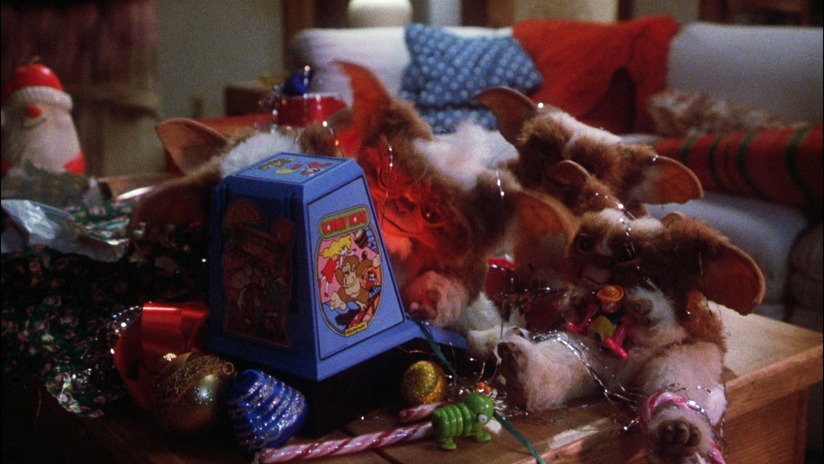During the holiday season, there are those who watch films with themes of joy, togetherness, and goodwill toward mankind. Then there are Horror fans. The former select their holiday movie fare based on its nostalgic appeal and its ability to recapture that old sense of childlike wonder. The Horror fans, just like everyone else, will hang their stockings with care, light the kinara, spin the dreidel, and bask in the warm glow of this magical season. When it comes time to settle in with some popcorn and a good flick, ever a dedicated bunch, Horror buffs will invariably opt for blood soaked mayhem, and there are plenty of holiday-themed Horror films to satisfy their bloodlust. Thirty years ago, Warner Brothers released Gremlins, which is now considered a classic in this very specific sub-genre, and horror fans would do well to revisit it this holiday season.

Anyone born after 1972 (give or take a few years) was probably too young to watch Gremlins (director, Joe Dante; writer, Chris Columbus) upon its release, but many saw it anyway. With the involvement of Steven Spielberg’s production company, Amblin Entertainment, Spielberg’s name prominently displayed on promotional posters and trailers (which emphasized mischief over violence), a wholesome protagonist, and a squee-inducingly adorable creature at the center of the plot, one cannot blame unsuspecting parents for being lulled into a false sense of security. Of course, there was that PG rating too. Even though it was marketed as a zany Horror-Comedy, Gremlins is more like Poltergeist (1982) Spielberg than E.T. the Extra-Terrestrial (1982) Spielberg, and upon revisiting the film, viewers might be surprised at the gore, the body count, the insinuations of animal cruelty, and the drunken shenanigans, among other family-unfriendly elements. For a child or even a “tween,” Gremlins might be upsetting, but for an adult, it is fun, and what really makes it worth a re-watch is that it addresses themes that most of us were too naive to understand when we were first introduced to the film.

Gremlins takes place in Kingston Falls, a snow-blanketed and depressed town, presumably in New York. The town is full of people who are out of jobs and struggling to make ends meet as Christmas and the high expectations associated with it rapidly and relentlessly approach. Randall Pelzer (Hoyt Axton) is a kindly, if inept, inventor who refuses to let financial troubles get in the way of procuring the perfect gift for his son Billy (Zach Galligan). He finds what he is looking for in a Chinatown shop: a small furry creature with huge eyes and a sweet habit of singing to itself in a cadence that sounds, in keeping with the ’80s theme, like a Kate Bush album played at 200 RPM. The creature, voiced by Howie Mandel (with no recording manipulation, as far as we know), is called a Mogwai, and it comes with a series of warnings that make it abundantly clear that caring for this creature requires more vigilance than would caring for the neediest of dogs — or infants, for that matter.

Billy is delighted with his early Christmas present, which his father has named Gizmo, and since Billy is clearly a responsible, decent young fellow, the viewer almost thinks this will work out just fine. However, through a series of mishaps, which, to be fair, are not really anyone’s fault, all three rules are broken, and it soon becomes clear just exactly why it is that Mogwai cannot be exposed to bright light, eat after midnight, and, most importantly, come into contact with water, for it is water that will cause a Mogwai to bear gremlins. First, the “offspring,” for lack of a better term, are just ornery versions of Gizmo, but assuming his clock is working, Billy accidentally feeds them after midnight, and they soon emerge from slimy cocoons as the green, scaly, evil creatures known as gremlins.
Both the gremlins of World War II pilot lore and the gremlins in the film are bent on causing destruction, particularly that of electrical and mechanical devices. Their activities result in a number of injuries and a few deaths, and since the police do not believe him and his father is now out of town at a conference, Billy must find a way to fight the gremlins himself. He receives help from Gizmo, love interest Kate (Phoebe Cates), and his mother Lynn (Frances Lee McCain), who fends off the gremlins remaining in the Pelzer household. Scenes where Lynn uses household items including a blender and a microwave to defeat the gremlins are among the goriest in the film. The human deaths are not nearly as graphic. The audience will in fact feel triumphant when Mrs. Deagle (Polly Holliday), a wealthy and greedy woman who out-Scrooges Scrooge when she threatens to kill Billy’s dog, plummets to her death after being flung out an upper-story window from her chair-lift.

The delineation between good and evil is apparent in this film, and for the most part, the righteous come out on top. Still, the violence in Gremlins was enough to raise alarm, and it was one of the films that prompted the introduction of the PG-13 rating, so use discretion when sharing this one with the little ones. Our generation is made of tougher material than the current one — or perhaps we just blocked out the trauma of seeing sweet Gizmo tremble in fear as his evil brethren wrought havoc around him.
A final surprise viewers will experience in revisiting Gremlins is that it does have some degree of depth and social commentary. The gremlins themselves and their actions can be read as symbols of a number of the more unsavory elements of society. In a scene where they infiltrate the local bar, for example, their gluttonous behavior and their cruelty toward Kate, who frantically tries to keep their glasses full, calls to mind the most debauched of frat parties or, to avoid singling out a particular group, the barbaric and entitled behavior associated with youth in general. The emphasis on the danger of technological failures highlights our dependency on machines and our ineptitude when those machines are taken away from us. That the film is set during the Christmas season in a town whose inhabitants are teetering on the edge of poverty reminds us of the consumerism that overshadows the real purpose of the celebration.

Gremlins was released to positive reception from critics and movie-goers alike, and it still holds up. There are rumors that Chris Columbus is working on a reboot, but amid the current backdrop of economic struggle, rampant consumerism, and a continuing dependency on technology, it almost seems as if nothing has changed since 1984. This might be a depressing thought, but at least Gremlins allows the viewer to confront it in a context where the good guys ultimately win, and hope never goes out of style.




No comment